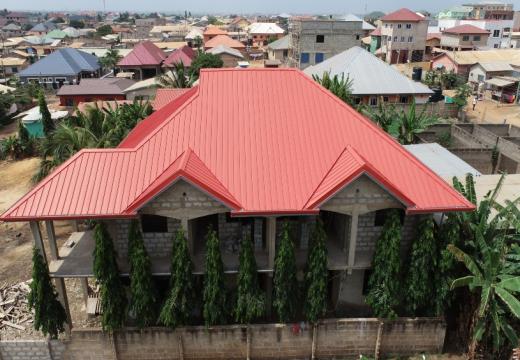A Guide To The Best Roofing Types and Styles in Ghana
A Guide To The Best Roofing Types and Styles in Ghana
- by PropHunt Admin
- On 09-01-2025
- at 1:00 PM

A roof forms part of a superstructure, which is usually the uppermost part of any building structure. Though there are different roofing styles and designs in Ghana to choose from, you’ll have to consider the location of your house and the direction of the wind before deciding on any particular roofing style in Ghana.
Choosing a roofing design for your house in Ghana does not come easy. You'll have to study the different roofing designs since each style has its unique characteristics. In this blog post, we will uncover the different roofing styles in Ghana and the factors to consider before choosing any roofing style.
The 8 Types of Roofing You Should Consider in Ghana
The popularity of simple house roof designs in Ghana has increased in recent years, along with their low-cost advantages. Keep reading this article as we discuss the different roofing designs in Ghana and their advantages.
1. Gable Roof
This is the traditional house roofing design in Ghana and is also a popular choice for many homeowners because of its affordability and durability. The gable roof is primarily the only roofing design that was known to the local Ghanaian carpenters for many years until the recent roof designs became popular in the country.
The gable roof is made up of two sloping sides that meet at a ridge to form a triangle. In gable roofing, there is always an A-shaped section of the wall where the sides are supported by rafters, which are long pieces of wood that run from the ridge to the walls of the house.
Some Advantages of a Gable Roof
-
Gable roofs are simple and easy to build.
-
Gable roofs can be adapted for a variety of architectural styles.
-
Gable roofs are strong and durable.
-
They provide good openings for ventilation.
-
Gable roofs are easy to maintain and repair.
2. Hip Roof
This roofing style typically has four sides that gently slope downhill to the walls and performs well in high-wind areas. A hip roof does not have a gable or vertical end. They provide excellent wind resistance for buildings in high-wind zones. Hip roofs are classified into three types: simple-hipped, cross-hipped, and half-hipped.
Some Advantages of a Hip Roof
-
Hip roofs are very durable and can withstand high winds and rainfall
-
Hip roofs are very watertight which allows water to flow easily
-
Hip roofs do not leak easily and are energy-efficient
-
Hip roofs can be used in a variety of home styles
-
Hip roofs are easy to maintain and do not require much upkeep
-
Hip roofs are relatively affordable to build.
3. Flat Roof
Homeowners in Ghana see flat roof styles as cost-effective options for roofing their homes since the style uses fewer materials in construction. This type of roofing is usually used for box houses in Ghana, where there is an extended two-course wall above the roofing height. It is one of the most attractive options for 3-4 bedroom houses since the installation is relatively quick and simple.
Some Advantages of a Flat Roof
-
Flat roofs are less expensive compared to other roofing types.
-
It is simple to construct and maintain.
-
It has cheap labor and saves time.
-
Flat roofs allow the use of many different roofing materials
-
A flat roof makes interior space more versatile.
4. Sloping Roof
This is one of the most popular roofs you can find in Ghana. It is most preferable for residential homes. The sloping house roof design has a steeply sloped roof that creates extra space, improving your house’s heating and cooling. Another advantage of a sloping roof is that it allows water, dirt, and other stuff to slide off without accumulation, giving you a lasting roof.
Some Advantages of a Sloping Roof:
-
It can help shed water and snow more effectively than a flat roof
-
It can create additional space in a home
-
It can be used to improve the energy efficiency of a home
-
It can add visual interest to a home
5. L-Shaped Roof
An L-shaped roof in Ghana is a type of roof that has two slopes, one of which is longer than the other. This type of roof is commonly seen in Ghanaian houses, with an L-shape indicating the long and short slopes. The longer slope is typically parallel to the long side of the building, while the shorter slope is parallel to the short side of the building.
L-shaped roofs are often used on buildings with a rectangular footprint, as they provide good drainage and ventilation and can create a more interesting visual effect than a traditional gable roof.
Some Advantages of an L-shaped roof:
-
They provide good drainage and ventilation.
-
They are relatively easy to construct.
-
They are relatively inexpensive to build.
-
They can create a more interesting visual effect
6. Lean-To-Roof
A lean-to roof is a single-sloped roof attached to an existing building. Homeowners in Ghana often use lean-to roofs for home and outbuilding additions. The most significant advantage of a lean-to roof is its easy construction. Since these roofs only have one slope, they don't require a lot of material or labor costs.
-
Lean-to roofs provide comfort for the installation of PV solar panels
-
It is one of the simplest, most affordable, and easily designed roofs
-
It has a high aesthetic appeal compared to other roof types
-
It lasts longer than a standard flat roof.
7. Mixed Roof
No doubt, if you want your house to stand out, use mixed roof designs. As the name suggests, this roofing style combines different roofing patterns, making it look attractive. This structure combines flat, gable, triangle, and semi-circle roofing designs, creating a unique beauty. It is further elevated by lighting and a combination of colors. The combination of various roof types offers the best possible function for any building in Ghana.
8. Curved Roof
This type of roofing in Ghana is commonly seen in industrial warehouse buildings where the roof is designed such that its Planes are curved, giving it a unique and very creative roof design. However, homeowners in Ghana who like this type of roof usually want their homes to stand out.
9. Pyramid Roof
A pyramid roof in Ghana takes the form of a hip roof, which has all four sides coming to a point at the top. It has no vertical sides or gables and is normally used for government residential buildings like bungalows, quarters, and storehouses. In Ghana, pyramid roofs are also sometimes used for larger buildings, such as churches, but they are not as common for this purpose.
10. Bonnet Roof
This type of roofing is not common in Ghana because it is not very practical in the country's climate. The double-sloped design means that the roof is not as effective at shedding rain as a single-sloped roof would be.
Factors To Consider When Choosing a Roof Design For Your Home in Ghana
When it comes to choosing a roof design for your home in Ghana, there are many factors that you should consider. From material selection to ventilation, let's discuss five essential things you should take into account before settling on a particular type of roofing system for your home in Ghana.
1. Your Budget
It is very common to see uncompleted houses with roofing frames without roofing materials simply because of a lack of budgeting. Homeowners in Ghana sometimes choose a particular roofing design without regard to their budget, and that often results in locked-up capital for projects without completion.
2. Selection of the Roof Material
Today, homeowners in Ghana have a wide variety of choices when it comes to roofing materials, from traditional aluminum roofing sheets to corrugated roofing sheets. However, each type of roofing material in Ghana has its advantages and disadvantages—for example, metal roofs tend to last much longer than aluminum sheets, but they may be more expensive. Remember that some roofing materials may not be suitable for certain climates or regions. For instance, in the northern part of Ghana, the sun is very hot and may not be suitable for plastic roofing material.
3. Open Ventilation Considerations
The design of your roof determines how well ventilation works. It is important that your roof has adequate ventilation to keep the temperature in your home comfortable; otherwise, you will have to equip your home with high air conditioning year-round. The right kind of ventilation will also help protect your roof from damage caused by extreme temperatures as well as help with moisture control.
4. The Pitch of the Roof
The pitch of your roof affects the overall cost and design of the house. It is important to note that a higher pitch will cost more but may add to the aesthetic appeal of your home, so it is worth considering this factor in relation to your budget.
3. Aesthetics
Last but not least, the look of your roof is an important factor to consider when selecting a design for your home in Ghana. Just like anyone else, you’ll want to have an attractive house, and the only thing that will be appealing to passersby is the roof. The house roof should complement the overall style of your house and fit in with the colors and textures used on other exterior surfaces.

 French
French




